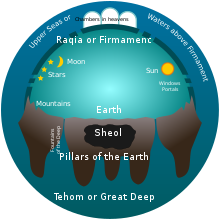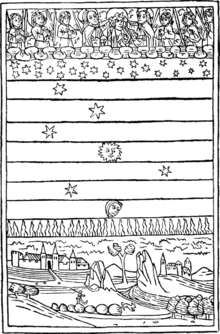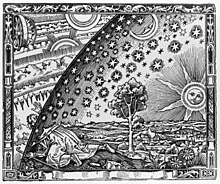
Flat Earth is an archaic and scientifically disproven conception of the Earth's shape as a plane or disk. Many ancient cultures subscribed to a flat-Earth cosmography. The model has undergone a recent resurgence as a conspiracy theory.

Heaven, or the heavens, is a common religious cosmological or transcendent supernatural place where beings such as deities, angels, souls, saints, or venerated ancestors are said to originate, be enthroned, or reside. According to the beliefs of some religions, heavenly beings can descend to Earth or incarnate and earthly beings can ascend to Heaven in the afterlife or, in exceptional cases, enter Heaven without dying.

Biblical cosmology is the account of the universe and its laws in the Bible. The Bible was formed over many centuries, involving many authors, and reflects shifting patterns of religious belief; consequently, its cosmology is not always consistent. Nor do the biblical texts necessarily represent the beliefs of all Jews or Christians at the time they were put into writing: the majority of the texts making up the Hebrew Bible or Old Testament in particular represent the beliefs of only a small segment of the ancient Israelite community, the members of a late Judean religious tradition centered in Jerusalem and devoted to the exclusive worship of Yahweh.
Chaos is the mythological void state preceding the creation of the universe in Greek creation myths. In Christian theology, the same term is used to refer to the gap or the abyss created by the separation of heaven and earth.

Caelus or Coelus was a primordial god of the sky in Roman mythology and theology, iconography, and literature. The deity's name usually appears in masculine grammatical form when he is conceived of as a male generative force.
The Genesis creation narrative is the creation myth of both Judaism and Christianity. The narrative is made up of two stories, roughly equivalent to the first two chapters of the Book of Genesis. In the first, Elohim creates the heavens and the Earth in six days, then rests on, blesses, and sanctifies the seventh. In the second story God creates Adam, the first man, from dust and places him in the Garden of Eden. There he is given dominion over the animals. Eve, the first woman, is created from Adam's rib as his companion.

Creatio ex nihilo is the doctrine that matter is not eternal but had to be created by some divine creative act. It is a theistic answer to the question of how the universe came to exist. It is in contrast to Ex nihilo nihil fit or "nothing comes from nothing", which means that all things were formed ex materia from preexisting things; an idea by the Greek philosopher Parmenides about the nature of all things, and later more formally stated by Titus Lucretius Carus.

Genesis 1:1 is the first verse of the first chapter of the Book of Genesis in the Hebrew and Christian Bibles and the opening of the Genesis creation narrative.

Genesis 1:2 is the second verse of the Genesis creation narrative. It is a part of the Torah portion Bereshit.
The Second Book of Enoch is a pseudepigraphic text in the apocalyptic genre. It describes the ascent of the patriarch Enoch, ancestor of Noah, through ten heavens of an Earth-centered cosmos. The Slavonic edition and translation of 2 Enoch is of Christian origin in the 8th century but is based on an earlier work. 2 Enoch is distinct from the Book of Enoch, known as 1 Enoch, and there is also an unrelated 3 Enoch, although none of the three books are considered canonical scripture by the majority of Jewish or Christian bodies. The numbering of these texts has been applied by scholars to distinguish each from the others.
Hebrew astronomy refers to any astronomy written in Hebrew or by Hebrew speakers, or translated into Hebrew, or written by Jews in Judeo-Arabic. It includes a range of genres from the earliest astronomy and cosmology contained in the Bible, mainly the Tanakh, to Jewish religious works like the Talmud and very technical works.

Ancient Greek astronomy is the astronomy written in the Greek language during classical antiquity. Greek astronomy is understood to include the Ancient Greek, Hellenistic, Greco-Roman, and late antique eras. Ancient Greek astronomy can be divided into three primary phases: Classical Greek Astronomy, which encompassed the 5th and 4th centuries BC, and Hellenistic Astronomy, which encompasses the subsequent period until the formation of the Roman Empire ca. 30 BC, and finally Greco-Roman astronomy, which refers to the continuation of the tradition of Greek astronomy in the Roman world. During the Hellenistic era and onwards, Greek astronomy expanded beyond the geographic region of Greece as the Greek language had become the language of scholarship throughout the Hellenistic world, in large part delimited by the boundaries of the Macedonian Empire established by Alexander the Great. The most prominent and influential practitioner of Greek astronomy was Ptolemy, whose treatise Almagest shaped astronomical thinking until the modern era. Most of the most prominent constellations known today are taken from Greek astronomy, albeit via the terminology they took on in Latin.

The term Hexaemeron, literally "six days," is used in one of two senses. In one sense, it refers to the Genesis creation narrative spanning Genesis 1:1–2:3: corresponding to the creation of the light ; the sky ; the earth, seas, and vegetation ; the sun and moon ; animals of the air and sea ; and land animals and humans. God then rests from his work on the seventh day of creation, the Sabbath.
Shamayim is the dwelling place of God and other heavenly beings according to the Bible. It is one of three components of the biblical cosmology. There are two other ones. Eretz (Earth), home of the living, and sheol, the realm of the dead—including, according to post Hebrew-Bible literature, the abode of the righteous dead.

A cosmic ocean, primordial waters, or celestial river is a mythological motif that represents the world or cosmos enveloped by a vast primordial ocean. Found in many cultures and civilizations, the cosmic ocean exists before the creation of the Earth. From the primordial waters the Earth and the entire cosmos arose. The cosmic ocean represents or embodies chaos.
Jewish cosmology refers to a cluster of cosmological views held in Jewish systems of thought and theology in premodern times. It may be treated separately from biblical cosmology which refers to the views concerning the origins (cosmogony) and structure (cosmography) of the cosmos in the Hebrew Bible. This includes literature from the period of Second Temple Judaism, rabbinic literature, para-rabbinic literature, and more.
The Hexaemeron of Jacob of Edessa is Jacob's commentary on the six days of creation of the Genesis creation narrative. Jacob worked on it in the first few years of the eighth century, as it was his final work. Unable to complete it within his own lifetime, the work was finished by his friend George, Bishop of the Arabs. It is an example of a work in the genre of Hexaemeral literature, but should not be confused with a similar earlier work, namely the Hexaemeron by Jacob of Serugh.
The Hexaemeron of Jacob of Serugh is a 6th-century text composed in the genre of Hexaemeral literature. As such, it offers a commentary on the Genesis creation narrative, and it is the first writing of this type to appear in the Syriac language. There was some precedent in the Commentary on Genesis by Ephrem the Syrian, but this was not a Hexaemeron. Likewise, there is no evident influence of a potential Syriac translation of the Hexaemeron of Basil of Caesarea on Jacob's work. Jacob dedicated a separate homily for each day of the creation week.

Ancient near eastern (ANE) cosmology refers to the plurality of cosmological beliefs in the Ancient Near East from the 4th millennium BC until the formation of the Macedonian Empire by Alexander the Great in the 4th century BC. This system of cosmology went on to have a profound influence on views in Egyptian cosmology, early Greek cosmology, Jewish cosmology, patristic cosmology, and Islamic cosmology. Until the modern era, variations of ancient near eastern cosmology survived with Hellenistic cosmology as the main competing system.
Early Greek cosmology refers to beliefs about the structure (cosmography) and origins (cosmogony) of the cosmos primarily from the 8th to 5th centuries BC before it was superseded by ancient Greek astronomy, which was demythologized and involved the systematic of the world. The main features of early Greek cosmography are shared with those found in ancient near eastern cosmology. The basic elements of the cosmos include earth, heaven, the sea, and the netherworld (Tartarus), the first three of which corresponded to the gods Gaia, Ouranos, and Oceanus.














